
Singapore has developed from a water-scarce developing nation to a world leader in water management in the space of a few decades. With a territory of just 720 square kilometres, Singapore is water-scarce not because of lack of rainfall, which is on average 2,300 millimetres per year, but because of the limited land area where water can be stored and the absence of aquifers. Since independence in 1965 one of the main concerns of the government has been how to provide clean water to its population and industries, which now consume about 430 million gallons of water per day.
Singapore imports its entitlement of water from the neighbouring Malaysian state of Johor under two agreements: one signed in 1961 and one signed in 1962. Both were guaranteed by the Government of Malaysia in the Independence of Singapore Agreement (known as the Separation Agreement) signed in 1965 that established Singapore as an independent country.
Under the agreement signed in 1961, Singapore had the full and exclusive right to draw off, take, impound, and use all the water within a designated land at Tebrau and Scudai Rivers for a period of 50 years up till 2011. Singapore shall pay to the Government of Johore (the then spelling) rent annually in advance in respect of any such land as may be reserved at the rate of $5 per acre per annum, and a charge of 3 cents for every 1,000 gallons of raw water it drew. It was also agreed that Singapore would provide Johore with a daily supply of treated water up to 12 percent of the raw water it drew at a price of 50 cents per 1,000 gallons. If the 12 percent provided by Singapore was insufficient, Johore could request for additional raw water to be supplied at a price of 25 cents for every 1,000 gallons of all such raw water supplied. This agreement expired in 2011 and was not renewed.
Under the agreement signed in 1962, the Government of Johore granted Singapore the full and exclusive right to draw off, take, impound and use the water from the Johore River up to a maximum of 250 million gallons per day for 99 years, until 2061. Singapore shall supply to the Government of Johore a daily amount of treated water not exceeding 2 percent of the total quantity of water supplied to Singapore. Singapore shall pay a charge of 3 cents for every 1,000 gallons. Johore shall pay to Singapore 50 cents for every 1,000 gallons of treated water supplied. If necessary, additional raw water would be supplied to the Government of Johore at 2 cents for every 1,000 gallons.
In view of the dependence for its water supply on another country, long-term security of water is an important consideration for Singapore. Therefore, the country has developed and executed plans for enhancing water security and self-sufficiency through out-of-the-box, creative thinking in all fields of water resources management. Innovations have covered aspects of policy, planning, management, organisation, resource development, finance, technology, and most recently society and behaviour.

Singapore’s entire water cycle is managed by the Public Utilities Board (PUB), the national water agency.
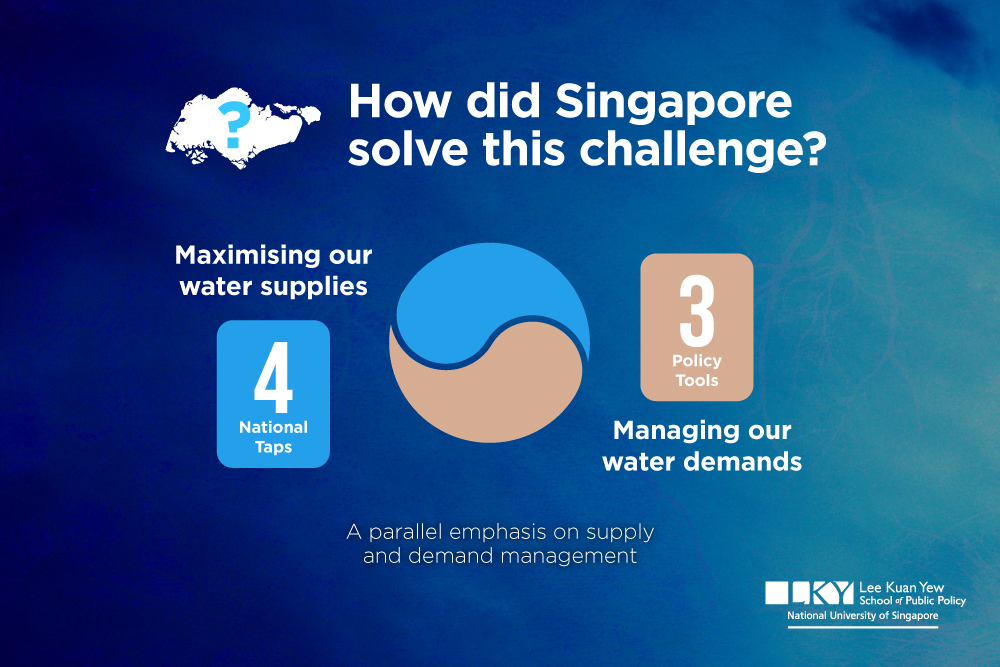 A main reason for Singapore’s success in managing its water is the parallel emphasis on supply and demand management, including wastewater and stormwater management; institutional effectiveness; planning on long time horizons; and an enabling environment which includes a strong political will, effective legal and regulatory frameworks, and an experienced and motivated workforce. Singapore’s entire water cycle is managed by the Public Utilities Board (PUB), the national water agency.
A main reason for Singapore’s success in managing its water is the parallel emphasis on supply and demand management, including wastewater and stormwater management; institutional effectiveness; planning on long time horizons; and an enabling environment which includes a strong political will, effective legal and regulatory frameworks, and an experienced and motivated workforce. Singapore’s entire water cycle is managed by the Public Utilities Board (PUB), the national water agency.
This brief examines the major features of Singapore’s water policies from the angles of water supply, water demand and overall governance.
Water supply
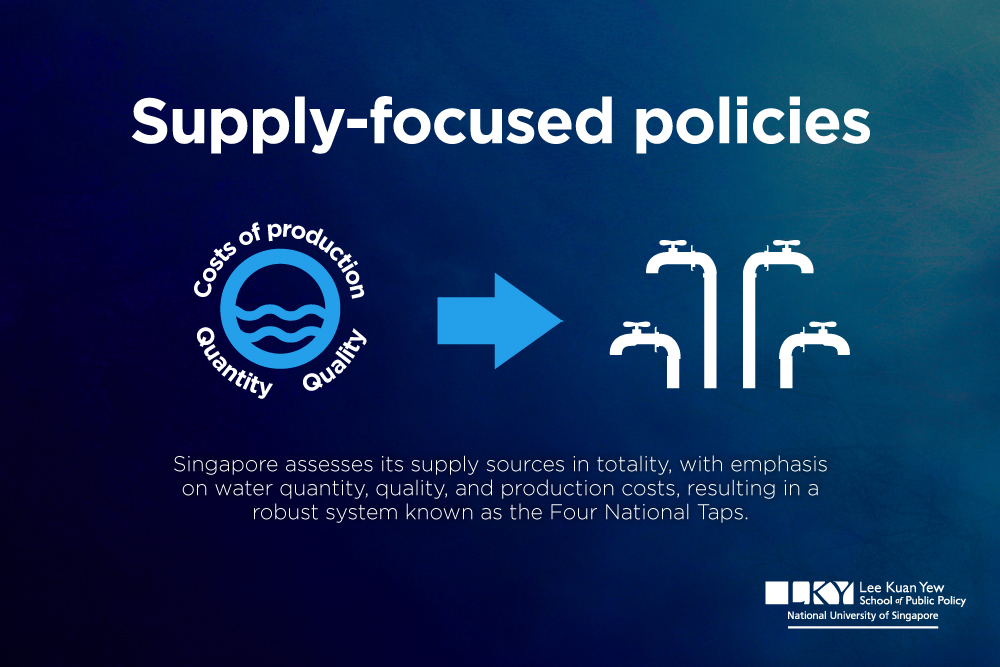 The 1972 Water Master Plan outlined a diversified water resources portfolio to cover future water and development needs. In addition to local water resources and imported water from Johor these included the development of unconventional sources of water such as recycled wastewater and desalinated water. Singapore is one of the very few countries that looks at its supply sources in their totality, and, in addition to water quantity, takes into account other aspects such as water quality and production and management costs. This has resulted in a robust water supply system, which is known as the Four National Taps (Figure 1).
The 1972 Water Master Plan outlined a diversified water resources portfolio to cover future water and development needs. In addition to local water resources and imported water from Johor these included the development of unconventional sources of water such as recycled wastewater and desalinated water. Singapore is one of the very few countries that looks at its supply sources in their totality, and, in addition to water quantity, takes into account other aspects such as water quality and production and management costs. This has resulted in a robust water supply system, which is known as the Four National Taps (Figure 1).
offline
Figure 1: Singapore’s Water Supply Source: https://www.pub.gov.sg/watersupply/singaporewaterstory
 Water from about 65% of Singapore’s land area is channelled into one of seventeen reservoirs, and this area will increase to 90% in the long run. The first reservoirs were constructed in the Central Catchment Area, which is a relatively pristine protected catchment. Subsequently reservoirs were developed in the less densely developed western part of Singapore, and finally in the densely developed eastern part, including the iconic Marina Reservoir in the Central Business District. Harvesting water from an urban catchment is unique and challenging in terms of water quality management. Hence, over the years there has been an increasing emphasis on catchment management. Protected and partially protected catchment areas are well demarcated and gazetted, and pollution-causing activities are not allowed in such areas. Existing polluting industries are, for instance, required to move outside the catchments when land leases expire or when areas are being redeveloped. Activities that can potentially affect water quality need to go through a stringent permitting process as there are specific pollution-control requirements for industrial operations. In 2006, the Active, Beautiful and Clean (ABC) Waters programme was launched. Though the programme has multiple objectives, which will be described further below, the Clean objective aims at slowing runoff and improving water quality in the catchment through the use of water design features such as biorentention ponds, bioswales and floating wetlands.
Water from about 65% of Singapore’s land area is channelled into one of seventeen reservoirs, and this area will increase to 90% in the long run. The first reservoirs were constructed in the Central Catchment Area, which is a relatively pristine protected catchment. Subsequently reservoirs were developed in the less densely developed western part of Singapore, and finally in the densely developed eastern part, including the iconic Marina Reservoir in the Central Business District. Harvesting water from an urban catchment is unique and challenging in terms of water quality management. Hence, over the years there has been an increasing emphasis on catchment management. Protected and partially protected catchment areas are well demarcated and gazetted, and pollution-causing activities are not allowed in such areas. Existing polluting industries are, for instance, required to move outside the catchments when land leases expire or when areas are being redeveloped. Activities that can potentially affect water quality need to go through a stringent permitting process as there are specific pollution-control requirements for industrial operations. In 2006, the Active, Beautiful and Clean (ABC) Waters programme was launched. Though the programme has multiple objectives, which will be described further below, the Clean objective aims at slowing runoff and improving water quality in the catchment through the use of water design features such as biorentention ponds, bioswales and floating wetlands.
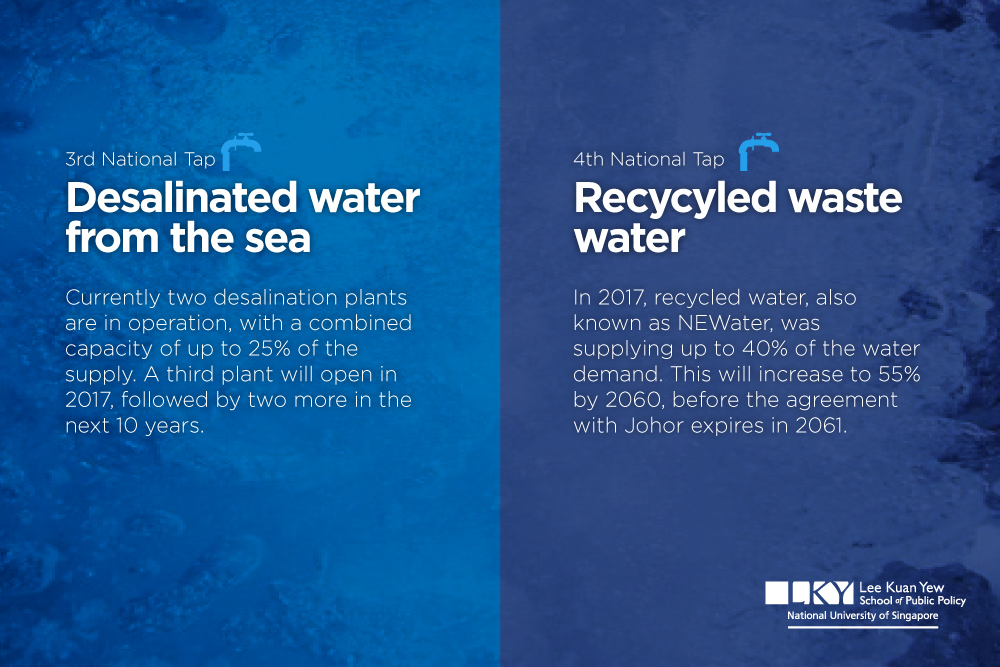 Desalination is becoming an important component in augmenting and diversifying available water sources. Currently two desalination plants are in operation, with a combined capacity of up to 25% of the supply. A third desalination plant will be opened in 2017, and the fourth and fifth are planned to be completed in the next 10 years. Even with increasing demand, desalination is expected to supply up to 30% of total demand in the long run. The desalination plants are designed, built, owned and operated by private-sector companies, from which PUB purchases the water.
Desalination is becoming an important component in augmenting and diversifying available water sources. Currently two desalination plants are in operation, with a combined capacity of up to 25% of the supply. A third desalination plant will be opened in 2017, and the fourth and fifth are planned to be completed in the next 10 years. Even with increasing demand, desalination is expected to supply up to 30% of total demand in the long run. The desalination plants are designed, built, owned and operated by private-sector companies, from which PUB purchases the water.
Singapore considered the possibility of recycling wastewater (or used water) as early as the 1970s. It opted for proper treatment of its effluents instead of discharging them to the sea. However, the first experimental recycling plant was closed in 1975 because it proved to be uneconomical and unreliable – the technology was still not mature. Efforts continued in 1998, when PUB and the Ministry of the Environment formulated a water reclamation study. Reclaimed water from a prototype plant, started in 2000, was monitored regularly for two years. An expert panel endorsed the safety and potability of the NEWater, a term now used for the treated used water. In 2002, an expert panel confirmed that NEWater was safe and could be used as a sustainable source of water supply for Singapore. It meets the water quality standards of the Environmental Protection Agency of the United States and the World Health Organisation.
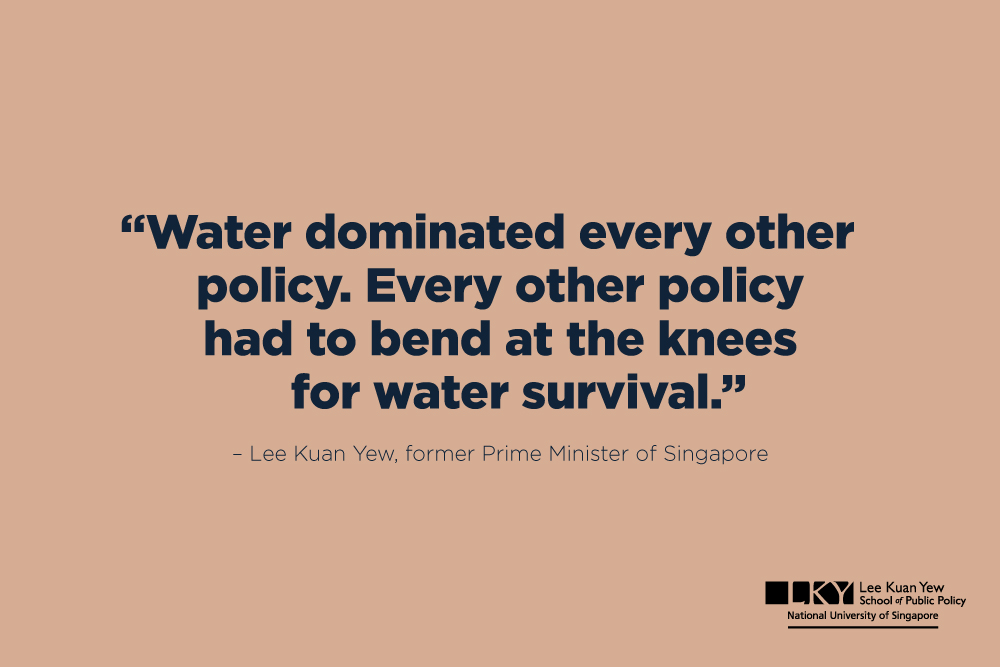 PUB collects, treats and reuses used water on an extensive scale, a step that very few countries have taken. Singapore has constructed separate drainage and sewerage systems to facilitate used water reuse on an extensive scale, including a Deep Tunnel Sewerage System that transports used water by gravity to the treatment plants.
PUB collects, treats and reuses used water on an extensive scale, a step that very few countries have taken. Singapore has constructed separate drainage and sewerage systems to facilitate used water reuse on an extensive scale, including a Deep Tunnel Sewerage System that transports used water by gravity to the treatment plants.
In 2017 NEWater was supplying up to 40% of the water demand; this is projected to increase to 55% in 2060, before the second water agreement with Johor expires in 2061. Production costs of NEWater are currently less than half of desalinated water. While NEWater is safe to drink, it is mainly used for industrial and commercial purposes. Since its purity is higher than tap water, it is economical for certain types of industrial manufacturing processes, such as semiconductors, which require ultra-pure water. For domestic water supply, NEWater is only used indirectly: small amounts of NEWater are pumped into reservoirs, where it mixes with water from other sources before treatment for domestic use. Persuading people to directly consume recycled water still faces emotional and psychological difficulties. An interesting policy in this respect is the language the Singapore government uses to change the negative connotation of recycled water: ‘used water’ instead of ‘wastewater’, ‘NEWater’ instead of ‘recycled water’, and ‘water reclamation plants’ instead of ‘wastewater treatment plants’. The introduction of this language was part of a larger communication plan at the introduction of NEWater aimed at shifting the mindset of the Singapore population, stressing that water should be seen as a renewable resource.
“In 2017 NEWater was supplying up to 40% of the water demand; this is projected to increase to 55% in 2060, before the second water agreement with Johor expires in 2061.”
The supply of water has been further expanded by reducing unaccounted-for water (UFW), which is defined as actual water loss due to leaks, plus apparent water losses arising from meter inaccuracies. Singapore does not have illegal connections, and all water connections are metered. UFW has decreased from about 9.5% in 1990 to about 5% in 2016, one of the lowest rates in the world.
Water demand
 Water demand has been increasing steadily with the rise in living standards and population and economic growth. By 2060 water demand is expected to be twice the amount in 2016. Aside from increasing supply through diversification and expansion of water sources, PUB has put in place well-thought-out and comprehensive demand management policies. The main tools are pricing, conservation policies and public education.
Water demand has been increasing steadily with the rise in living standards and population and economic growth. By 2060 water demand is expected to be twice the amount in 2016. Aside from increasing supply through diversification and expansion of water sources, PUB has put in place well-thought-out and comprehensive demand management policies. The main tools are pricing, conservation policies and public education.
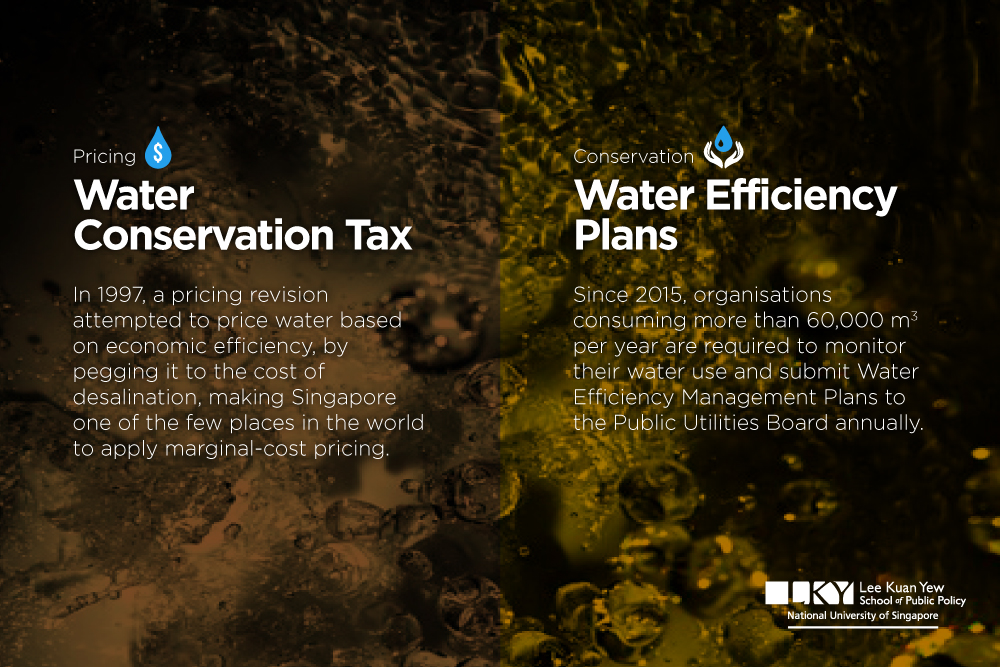 Before the 1990s water prices were mainly set to ensure cost recovery of water supply. Low tariffs – the cost of water and wastewater services was less than 0.5% of average household income – meant that there was little incentive for water conservation. An increasing block tariff structure introduced in 1973 did, however, target reducing water wastage. In 1991 an explicit tax aimed at water conservation was put in place. It applied to domestic (household) consumption above 20 cubic metres per month and to all non-domestic use, but the basis for determining the tax quantum was not clear. In 1997 a significant pricing revision attempted to price water based on economic efficiency. The water price was pegged to the cost of desalination to reflect the higher price of alternative supply sources, making Singapore one of the few places in the world applying marginal-cost pricing. The water conservation tax was applied to all water consumed, to signal the importance of water as a strategic resource. For domestic use a two-tiered tariff with higher prices for consumption above 40 cubic metres per month was applied. A volumetric fee and a sanitary appliance fee were charged for used water. The changes were introduced over a period of four years to make them easier for consumers to accept. Water prices did not change between 2000 and 2017, aside from the introduction of a separate tariff for NEWater. In 2017 the government announced a price increase of 30%, to be implemented over two years, to cover the increased costs of water supply. The volumetric fee for used water was increased and the sanitary appliance fee was abolished.
Before the 1990s water prices were mainly set to ensure cost recovery of water supply. Low tariffs – the cost of water and wastewater services was less than 0.5% of average household income – meant that there was little incentive for water conservation. An increasing block tariff structure introduced in 1973 did, however, target reducing water wastage. In 1991 an explicit tax aimed at water conservation was put in place. It applied to domestic (household) consumption above 20 cubic metres per month and to all non-domestic use, but the basis for determining the tax quantum was not clear. In 1997 a significant pricing revision attempted to price water based on economic efficiency. The water price was pegged to the cost of desalination to reflect the higher price of alternative supply sources, making Singapore one of the few places in the world applying marginal-cost pricing. The water conservation tax was applied to all water consumed, to signal the importance of water as a strategic resource. For domestic use a two-tiered tariff with higher prices for consumption above 40 cubic metres per month was applied. A volumetric fee and a sanitary appliance fee were charged for used water. The changes were introduced over a period of four years to make them easier for consumers to accept. Water prices did not change between 2000 and 2017, aside from the introduction of a separate tariff for NEWater. In 2017 the government announced a price increase of 30%, to be implemented over two years, to cover the increased costs of water supply. The volumetric fee for used water was increased and the sanitary appliance fee was abolished.
Low- and middle-income households are compensated with vouchers (U-Save rebates), which can be used for all utilities and are decoupled from actual use. This means that the poor receive a targeted subsidy rather than the ‘lifeline’ tariff used in many countries. This is much more efficient, socio-economically, than providing subsidised water to all households irrespective of their economic conditions. All revenues collected through water tariffs accrue to PUB, except for the water conservation tax. This means that there is clarity on the financial viability of PUB’s operations and investments.
The use of water conservation requirements and engineering solutions goes back to the late 1970s, when PUB embarked on a study to test flow-restriction thimbles for water savings. In the 1990s an extensive study was conducted on the use of low-flow cisterns, and they were mandated after all doubts regarding hygiene and the flow of wastewater in the sewerage system were cleared. Since then, maximum allowable flow rates for taps and mixers have been introduced, as well as a Water Efficiency Labelling Scheme for the sale of taps, mixers, urinals, clothes washing machines, etc. Only appliances and machines with acceptable efficiency ratings can be sold in Singapore. To encourage replacement of existing water closets in older estates, a community project for lower-income families was recently introduced.
Water conservation is encouraged and mandated in the non-domestic sector as well. Since 2015 organisations consuming more than 60,000 cubic metres per year are required to monitor their water use and submit Water Efficiency Management Plans to PUB annually. This serves as a stimulus for water conservation, and it provides PUB with data on non-domestic water use to inform targeted conservation measures. Organisations can apply to a Water Efficiency Fund for support in implementing projects that improve water efficiency. A Water Efficient Building certification encourages building owners to install water-efficient fittings.
Non-compliance with mandatory measures can be dealt with under the Public Utilities Act and its subsidiary legislation, which stipulates fines and severe penalties for issues such as water wastage and damaging the supply network.
“Water conservation forms part of the syllabus of primary school students; education programmes and materials for foreign construction workers and domestic helpers (a sizeable part of Singapore’s population) have been developed; and campaigns such as the 10-Litre Challenge (reduce daily consumption by 10 litres) and keeping showering time under 5 minutes have been launched.”
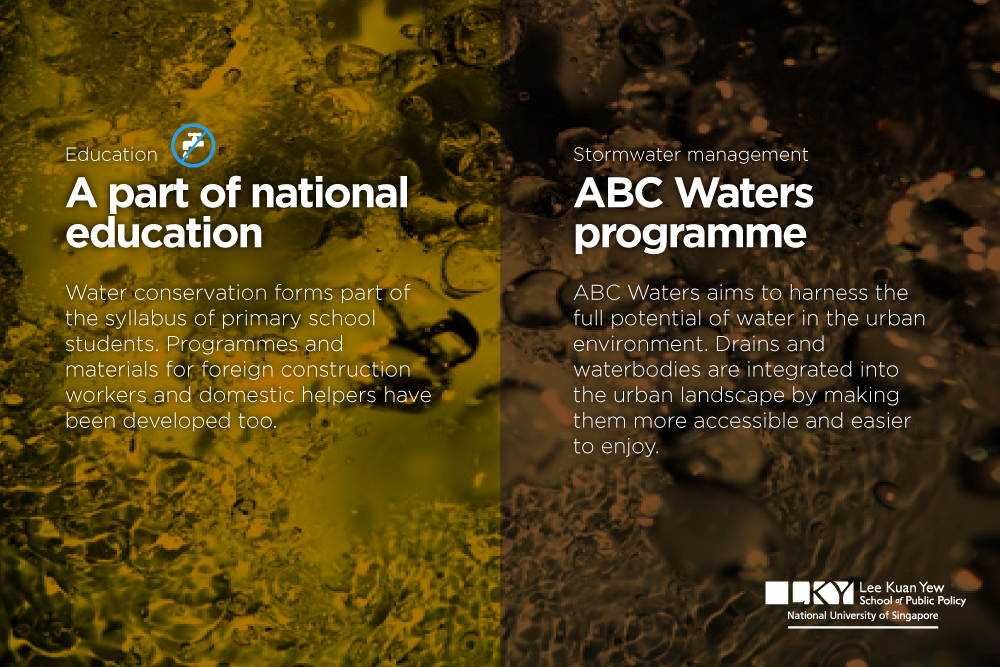 Finally, public education forms an important pillar of water demand policies in Singapore, and a multitude of initiatives exist. Water conservation forms part of the syllabus of primary school students; education programmes and materials for foreign construction workers and domestic helpers (a sizeable part of Singapore’s population) have been developed; and campaigns such as the 10-Litre Challenge (reduce daily consumption by 10 litres) and keeping showering time under 5 minutes have been launched. The Marina Barrage, which created the Marina Reservoir, was designed as a public space, and includes an exhibition on Singapore’s water. One of the NEWater plants includes a visitor centre where people can learn about the production of recycled water. The Singapore Water Academy offers specialised programmes for water professionals.
Finally, public education forms an important pillar of water demand policies in Singapore, and a multitude of initiatives exist. Water conservation forms part of the syllabus of primary school students; education programmes and materials for foreign construction workers and domestic helpers (a sizeable part of Singapore’s population) have been developed; and campaigns such as the 10-Litre Challenge (reduce daily consumption by 10 litres) and keeping showering time under 5 minutes have been launched. The Marina Barrage, which created the Marina Reservoir, was designed as a public space, and includes an exhibition on Singapore’s water. One of the NEWater plants includes a visitor centre where people can learn about the production of recycled water. The Singapore Water Academy offers specialised programmes for water professionals.
In addition, the ABC Waters programme plays an important role in creating shared ownership of water. As a programme for holistic stormwater management, it aims to harness the full potential of water in the urban environment. Drains and waterbodies are integrated into the urban landscape by making them more accessible and easier to enjoy. Projects include greening of concrete canals (with, as a showcase project, the conversion of a 3-kilometre concrete drain into a meandering stream in Bishan - Ang Mo Kio Park), construction of accessible (floating) wetlands, and providing facilities for water sports on reservoirs. In total 100 projects have been identified around Singapore, and about 30 have been realised so far. The ABC Waters programme was a large shift from the previous approach of PUB, which aimed at protecting water bodies and hence disconnected people from water.
Overall governance
Institutionally, PUB, a statutory board under the Ministry of Environment and Water Resources, is one of the few agencies in the developed or developing world that manages all aspects of water resources, including resource management, supply, sanitation and drainage. Typically services are divided among two or more organisations, and institutional fragmentation can lead to lack of coordination. This is less likely when only one agency is in charge. In line with Singapore’s national culture, there is a strong focus on anti-corruption, management is effective and appointments are merit-based. Staff are offered competitive remuneration and benefits, benchmarked to market rates, and offered training opportunities.
Where PUB has no special competence or competitive advantage, it uses the private sector extensively. Aside from striving for the lowest-cost alternative, collaborations with the private sector and research institutes focus on R&D as outlined in a Technology Roadmap. Focus areas of research include reducing the cost of desalination and NEWater production, particularly through more energy-efficient processes, increasing the yield of water reclamation from 75% now to 90% in future, using seawater for industrial cooling, and managing water demand through influencing behaviour. The Ministry of Environment and Water Resources has set up the Environment & Water Industry Development Council (EWI), led by PUB, and the Economic Development Board (EDB) to establish Singapore as a global ‘hydrohub’, a leading centre for business opportunities and expertise in water technologies. Currently about 180 water-related companies and research organisations are based in Singapore, and the Singapore International Water Week, held biannually, is one of the largest global water conferences.
To achieve Singapore’s sustainability and resilience in the future, the city state established the Inter-Ministerial Committee on Climate Change in 2007 and the Centre for Climate Research in 2013. These aim at coordinating climate policies and strengthening in-house climate science. PUB has an important role in these organisations and has developed plans to ensure water supply during extreme droughts and reduce flood risks.
Conclusions
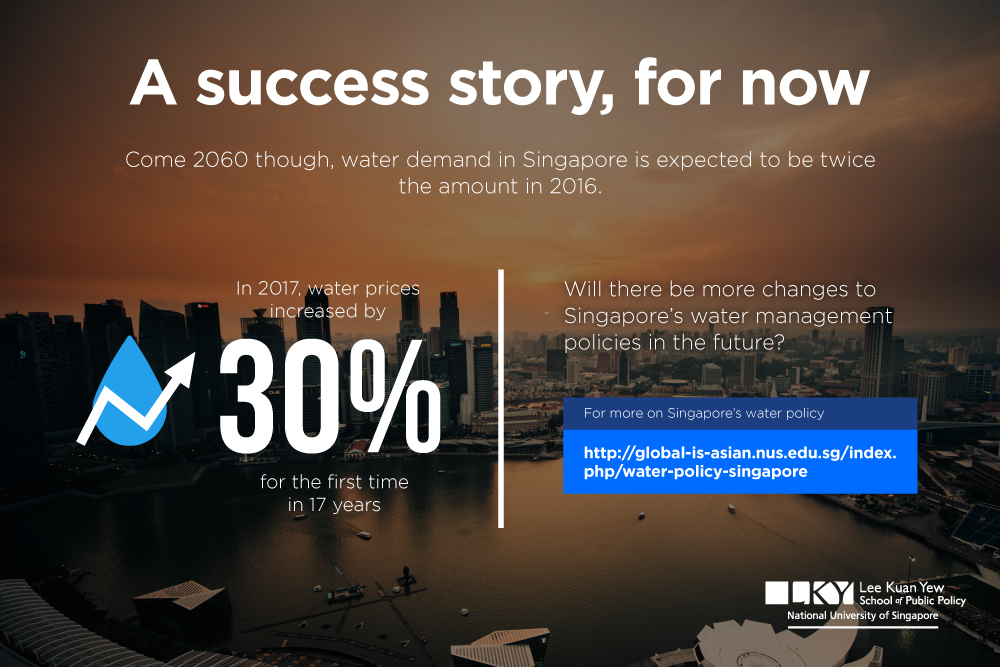 Singapore has found the right balance between water quantity and quality considerations, water supply and demand management, public-sector and private-sector participation, efficiency and equity concerns, strategic national interest and economic efficiency, and strengthening internal capacities and reliance on external sources. By ensuring efficient use of its limited water resources through economic instruments, adopting the latest technological developments to produce ‘new’ sources of water, enhancing storage capacities by proper catchment management, practising water conservation measures, and ensuring concurrent consideration of social, economic and environmental factors, Singapore has reached a level of holistic water management that can be an example for other urban centres.
Singapore has found the right balance between water quantity and quality considerations, water supply and demand management, public-sector and private-sector participation, efficiency and equity concerns, strategic national interest and economic efficiency, and strengthening internal capacities and reliance on external sources. By ensuring efficient use of its limited water resources through economic instruments, adopting the latest technological developments to produce ‘new’ sources of water, enhancing storage capacities by proper catchment management, practising water conservation measures, and ensuring concurrent consideration of social, economic and environmental factors, Singapore has reached a level of holistic water management that can be an example for other urban centres.
References
Tortajada, C (2007), Water Management in Singapore, Ethos, Issue 2.
Tortajada, C, Joshi, Y and Biswas, A (2013), The Singapore Water Story, Routledge
Tortajada, C (2017), Water: Societal changes boost systems innovation, The Straits Times, 7 January 2017.
Public Utilities Board (2016), Our Water, Our Future, https://www.pub.gov.sg/Documents/PUBOurWaterOurFuture.pdf
Download full article